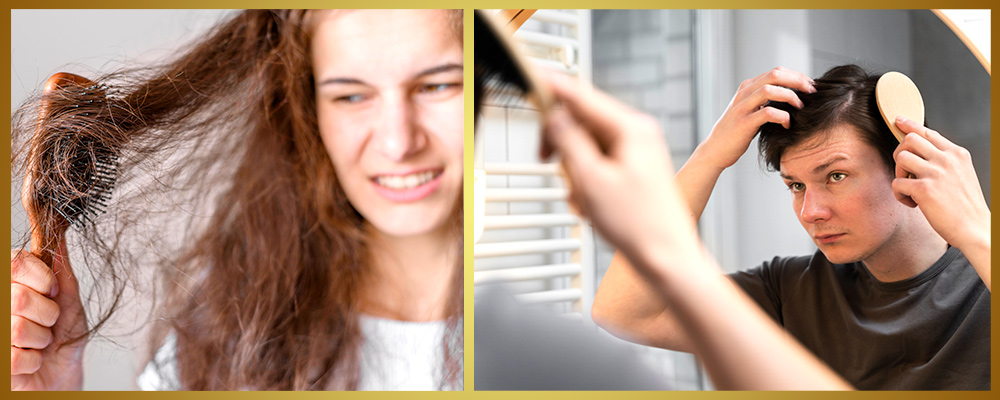Table of Contents
Hair Damage: Types, Symptoms, and Causes
Hair damage is a widespread concern that affects the texture, health, and overall appearance of the hair. Understanding the types, symptoms, causes, diagnosis, and treatments for hair damage is key to restoring hair health and preventing further damage. In this guide, we’ll explore the various aspects of hair damage, when to seek medical advice, and how to address the issue.
Types of Hair Damage
1. Heat Damage
Excessive use of heat-styling tools like straighteners, curling irons, and hair dryers can strip hair of natural moisture, making it brittle and frizzy. Over time, this weakens hair follicles, leading to split ends and breakage.
2. Chemical Damage
Chemical treatments such as coloring, bleaching, perming, or relaxing can weaken the hair’s protein structure. This results in dryness, cracking, and a straw-like appearance, making overly processed hair more likely to thin and fall out.
3. Environmental Damage
Exposure to environmental factors like UV rays, pollution, salt water, and chlorine can damage the hair’s natural barrier, resulting in dry, dull, and lifeless hair.
4. Mechanical Damage
Frequent brushing with the wrong type of brush or using harsh hairstyles (e.g., tight ponytails or braids) can lead to mechanical damage. This constant stress and friction make hair more susceptible to breakage and split ends.
5. Humidity Imbalance
Hair can suffer from too little or too much moisture. Dry hair is prone to breakage, while overly moisturized hair can become weak and stretched, causing similar damage.
Recognizing these types of damage is crucial for maintaining healthy hair.
Symptoms
a. Dry, brittle strands
b. Frizziness and lack of smoothness
c. Split ends that travel up the hair shaft
d. Breakage or shedding during brushing or styling
e. Loss of natural shine and elasticity
d. Tangled and knotted hair, especially after washing
e. Hair that feels rough to the touch or appears dull
When to See a Doctor
You should consider seeking medical advice if you experience:
a. Severe breakage or hair thinning that worsens over time
b. Bald patches or scalp irritation like itching, redness, or flakes
c. Hair damage that persists despite improving hair care practices
d. Hair loss that is accompanied by fatigue, weight loss, or other unusual symptoms
e. A family history of hair disorders or conditions like alopecia
In such cases, a dermatologist can help diagnose any underlying conditions and provide specialized treatment.
Causes
1. Overuse of Heat Styling Tools
Regular use of high-heat tools like straighteners and curling irons can fry the hair, depleting its moisture content. This results in hair that is dry, brittle, and more likely to break.
2. Chemical Treatments
Harsh chemical processes like bleaching, dyeing, and relaxing strip the hair of its natural proteins, leaving it weakened. Frequent chemical treatments without proper care can lead to severe hair damage and thinning.
3. Environmental Exposure
Sun exposure, wind, saltwater, and chlorine can damage the outer cuticle of the hair. Prolonged exposure to these elements without protection makes hair more susceptible to dryness and frizz.
4. Poor Hair Care Practices
Using the wrong type of shampoo, over-washing, or neglecting conditioner can strip the hair of essential oils. Additionally, aggressive towel drying or frequent brushing can cause mechanical damage, resulting in split ends and breakage.
5. Nutritional Deficiencies
Lack of essential nutrients like vitamin E, biotin, and iron can affect the health of your hair. Without the right nutrition, hair is unable to grow strong and can become thin, weak, and more prone to damage.
Diagnosis
To accurately diagnose hair damage, a healthcare professional or dermatologist will perform a thorough assessment. Diagnostic steps may include:
1. Visual Examination: Checking for signs of damage such as split ends, breakage, or frizz.
2. Hair Pull Test: Evaluating the amount of hair that sheds when gently pulled can help assess the severity of damage.
3. Microscopic Hair Analysis: In some cases, a close inspection of hair strands under a microscope can reveal damage to the cuticle or cortex.
4. Scalp Condition: A doctor may also check the scalp for any inflammation or signs of scalp diseases that may be contributing to hair damage.
Treatments for Hair Damage
1. Moisturizing treatment
Deep conditioning masks with ingredients like keratin or argan oil moisturize and repair damaged hair. Meanwhile, protein treatments strengthen hair and reduce breakage caused by heat or chemicals.
2. Fixing and regular maintenance
Olaplex or bonding treatments repair broken bonds in the hair that have been weakened by chemicals or heat damage. Regular trimming will help remove split ends. Prevents further breakage
3. Train your hair to be strong
Limit heat styling and the use of chemicals. Use a sulfate-free shampoo and conditioner to maintain moisture. Stay hydrated by drinking water. And eating foods high in nutrients such as Omega 3 and Biotin for overall hair health…



